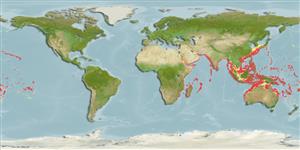>
Eupercaria/misc (Various families in series Eupercaria) >
Lutjanidae (Snappers) > Etelinae
Etymology: Etelis: Greek, etelis, -idos = a fish, perhaps the fish Sparus aurata (Ref. 45335).
More on author: Valenciennes.
Environment: milieu / climate zone / depth range / distribution range
Ecologie
marien rifbewoner; diepte 45 - 400 m (Ref. 9821), usually 90 - 400 m (Ref. 9821). Deep-water; 38°N - 32°S, 29°E - 139°W
Indo-Pacific: East Africa eastward to the Hawaiian Islands, north to Sea of Japan, south to Australia (Queensland and New South Wales) and Lord Howe Island; off Kermadec Islands, northeast of New Zealand (Ref. 9821). Reported from the Marquesas (Ref. 114223). The name Etelis carbunculus has been misapplied to this species by some previous authors.
Lengte bij maturiteit / Grootte / Gewicht / Leeftijd
Maturity: Lm 66.3, range 52 - ? cm
Max length : 120 cm TL mannelijk / geslacht onbekend; (Ref. 5484); common length : 50.0 cm SL mannelijk / geslacht onbekend; (Ref. 9821)
Dorsale stekels (totaal) : 10; Dorsale zachte stralen (totaal) : 11; Anale stekels: 3; Anale zachte stralen: 8. Interorbital space flat. Maxilla covered with scales. Dorsal and anal fin bases without scales. Upper caudal lobe becoming greatly elongated with increased growth. Scale rows on back parallel with lateral line. Back and upper sides deep pink to red; lower sides and belly pink; fins pink to red.
Adults inhabit rocky bottoms (Ref. 30573) of the continental shelf and continental slope (Ref. 75154). Benthopelagic (Ref. 58302). Feed on small fishes, squids and crustaceans (Ref. 30573). Considered an important food fish in some areas. Marketed fresh and frozen (Ref. 9987). Highly valued for the quality of its flesh (Ref. 11888). Mnimum depth from Ref. 089972.
Levenscyclus en paargedrag
Maturities | Voortplanting | Spawnings | Egg(s) | Fecundities | Larven
Allen, G.R., 1985. FAO Species Catalogue. Vol. 6. Snappers of the world. An annotated and illustrated catalogue of lutjanid species known to date. FAO Fish. Synop. 125(6):208 p. Rome: FAO. (Ref. 55)
Status op de Rode Lijst van het IUCN (Ref. 130435)
Gevaar voor de mens
Harmless
Gebruik door de mens
Visserij: van groot commercieel belang; sportvis: ja; aas: occasionally
Tools
Speciale rapporten
Download XML
Internetbronnen
Estimates based on models
Preferred temperature (Ref.
123201): 9.9 - 24.8, mean 17 °C (based on 829 cells).
Fylogenetische diversiteitsindex (Ref.
82804): PD
50 = 0.5625 [Uniqueness, from 0.5 = low to 2.0 = high].
Bayesian length-weight: a=0.01660 (0.01348 - 0.02042), b=2.95 (2.89 - 3.01), in cm total length, based on LWR estimates for this species (Ref.
93245).
Trofisch niveau (Ref.
69278): 4.4 ±0.2 se; based on diet studies.
Weerstandsvermogen (Ref.
120179): laag, minimale populatieverdubbelingstijd 4,5-14 jaar (K=0.12; tmax=20).
Fishing Vulnerability (Ref.
59153): Moderate to high vulnerability (45 of 100).
Nutrients (Ref.
124155): Calcium = 5.05 [2.53, 11.76] mg/100g; Iron = 0.208 [0.098, 0.492] mg/100g; Protein = 18.9 [17.0, 20.7] %; Omega3 = 0.224 [0.114, 0.423] g/100g; Selenium = 12.7 [5.2, 31.1] μg/100g; VitaminA = 35.8 [6.8, 215.2] μg/100g; Zinc = 0.242 [0.151, 0.381] mg/100g (wet weight);
